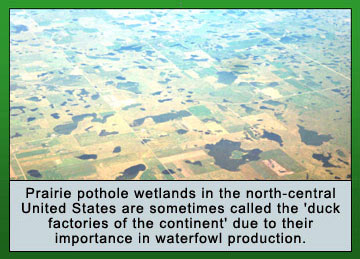Summary
Wetlands provide many societal benefits: food and habitat for fish and wildlife, including threatened and endangered species; water quality improvement; flood storage; shoreline erosion control; economically beneficial natural products for human use; and opportunities for recreation, education, and research. Use the links below to view a detailed list of functions and values and to check your retention of this information by taking the self-test.
A complete list of all the important Wetlands Functions and Values in this module
Test Your Knowledge
Acknowledgments
The text of this module was derived, with substantial modifications and additions, from two EPA publications, America's Wetlands: Our Vital Link Between Land and Water (1995) and Wetlands Fact Sheets (1995). Other references and online sources used are given below.
The author appreciates the review of drafts of this module by Donna An, Rachel Doughty, George Loeb, John McShane, John Meagher, Tracie Nadeau, Douglas Norton, Sean Sipple, Lynne Trulio and Alan Wright.
Appreciation is also expressed for the use of figures and photos from America's Wetlands: Our Vital Link Between Land and Water (USEPA, 1995). Photo credits are listed under each photo in the module.
References
Ewel,
K. 1990. Multiple demands on wetlands: Florida cypress swamps can serve as
a case study. Bioscience 40:660-666.
Feierabend, S.J., and J.M. Zelazny. 1987. Status Report on Our Nation's
Wetlands. Washington, DC: National Wildlife Federation. 50 pp.
Lewis, R.R. 1990. Creation and restoration of Coastal Plain wetlands in Florida.
In Wetland Creation and Restoration: The Status of the Science, ed.
Kusler and Kentula, pp. 73-101.
Mitsch, W.J., and J.G. Gosselink. 1993. Wetlands. 3rd ed. New York:
Van Nostrand Reinhold.
Office of Technology Assessment. 1993. Preparing for an Uncertain Climate.
Vol. II. OTA-O-568. Washington, DC: U.S. Government Printing Office.
Perry, M.C., and A.S. Deller. 1994. Waterfowl population
trends in the Chesapeake Bay area. In Toward a Sustainable Coastal Watershed:
The Chesapeake Bay Experiment, proceedings of the 1994 Chesapeake Research
Conference, June 1-3, 1994, Norfolk, VA, pp. 490-504.
Sipple, W.S. 1999. Days Afield: Exploring Wetlands
in the Chesapeake Bay Region. Baltimore, MD: Gateway Press. 558 pp.
U.S. Environmental Protection Agency. 1994. National
Water Quality Inventory: 1992 Report to Congress. EPA 841-R-94-001. Washington,
DC: U.S. Environmental Protection Agency
U.S. Environmental Protection Agency. 1995a. Wetlands Fact Sheets.
EPA843-F-95-001. Office of Water, Office of Wetlands, Oceans and Watersheds.
U.S. Environmental Protection Agency. 1995b. America's
Wetlands: Our Vital Link Between Land and Water. EPA843-K-95-001. Washington,
DC: U.S. Environmental Protection Agency, Office of Water, Office of Wetlands,
Oceans and Watersheds.
Online Sources
Manomet
Center for Conservation Sciences, Research and Conservation Initiatives.
![]()
National Oceanic and Atmospheric Administration.
1995a. A $1.01 Million Project to Restore Wetlands in Louisiana to Combat
Severe Shoreline Erosion. Retrieved April 19, 1995, from URL
North Carolina State University. Values of Wetlands.
Retrieved December 5, 2000.
![[logo] US EPA](https://www.epa.gov/epafiles/images/logo_epaseal.gif)
